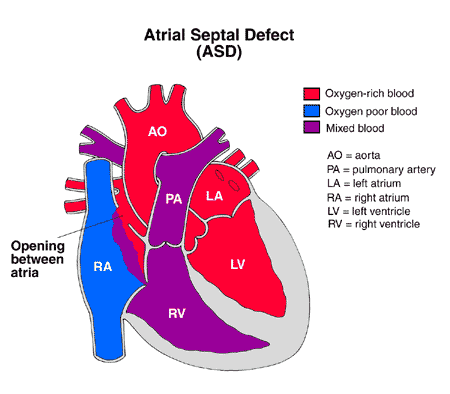Atrial Septal Defect (ASD) Causes, Symptoms, Diagnosis and Treatment

What Is Atrial Septal Defect?
Atrial septal defect is a congenital heart defect in which blood flows between the atria (upper chambers) of the heart.
Normally, the atria are separated by a dividing wall, the interatrial septum.
If this septum is defective or absent, then oxygen-rich blood can flow directly from the left side of the heart to mix with the oxygen-poor blood in the right side of the heart, or vice versa.
This can lead to lower-than-normal oxygen levels in the arterial blood that supplies the brain, organs, and tissues.
An ASD may not produce noticeable signs or symptoms, especially if the defect is small. In contrast to this, large and long-standing atrial septal defects can damage the heart and lungs.
Atrial septal defects can be several types, including:
- Secundum.
This is the most common type of ASD, and occurs in the middle of the wall between the atria (atrial septum). - Primum.
This defect occurs in the lower part of the atrial septum, and may occur with other congenital heart problems. - Sinus venosus.
This rare defect occurs in the upper part of the atrial septum. - Coronary sinus.
In this rare defect, part of the wall between the coronary sinus — which is part of the vein system of the heart — and the left atrium is missing.
Causes Of Atrial Septal Defect:
Although the underlying cause of atrial septum defect is yet unknown, the following conditions have been linked to it:
- Down syndrome – patients with Down syndrome have higher rates of ASDs. As many as one half of Down syndrome patients have some type of septal defect.
- Ebstein’s anomaly – About 50% of individuals with Ebstein anomaly have an associated shunt between the right and left atria, either an atrial septal defect or a patent foramen ovale.
- Fetal alcohol syndrome– about one in four patients with fetal alcohol syndrome has either an ASD or a ventricular septal defect.
- Holt–Oram syndrome – Both the osteium secundum and osteum primum types of ASD are associated with Holt–Oram syndrome
- Lutembacher’s syndrome – the presence of a congenital ASD along with acquired mitral stenosis
Symptoms Of Atrial Septal Defect:
Atrial septal defect signs and symptoms may include:
- Shortness of breath, especially when exercising
- Fatigue
- Swelling of legs, feet or abdomen
- Heart palpitations or skipped beats
- Frequent lung infections
- Stroke
- Heart murmur, a whooshing sound that can be heard through a stethoscope
Diagnosis Of Atrial Septal Defect:
The following tests and exams help confirm the diagnosis of ASD:
- Echocardiogram
- Chest x-ray
- ECG
- Cardiac catheterization
- MRI
- CT scan
Treatment Of Atrial Septal Defect:
The following treatment options are available:
- Medical monitoring
- Medications
Beta blockers
Anticoagulants - Surgery
Cardiac catheterization
Open heart surgery
By : Natural Health News




